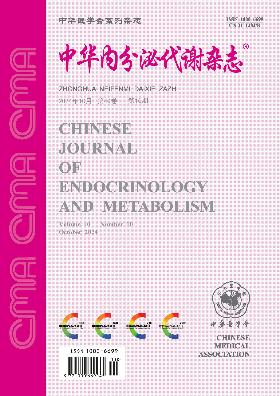高尿酸血症患者黄嘌呤氧化酶活性及影响因素分析
Q4 Medicine
引用次数: 0
摘要
目的评价和比较高尿酸血症患者和健康人黄嘌呤氧化酶(XO)活性的差异,并分析其影响因素。方法选择男性高尿酸血症患者129例,其中痛风患者112例,单纯高尿酸症患者17例。同时,随机抽取95名男性健康志愿者作为对照组。采用酶联免疫吸附法(ELISA)测定血清XO活性。采用独立t检验进行两两比较,采用多元线性回归分析分析独立影响因素。结果与正常对照组相比,高尿酸血症患者XO活性显著升高[(159.6±4.0 vs 138.7±7.5)U/L,P<0.05]。相关分析表明,XO活性与体重指数、腰臀比、舒张压、总胆固醇、血尿酸、肌酸酐、空腹血糖呈正相关,和尿酸清除率水平。在逐步多元回归分析中,XO活性被用作因变量。结果表明,腰臀比和尿酸清除率是影响XO活性的因素。结论高尿酸血症患者XO活性升高,肥胖尤其是腹部肥胖是XO活性的独立危险因素;提示控制腹部肥胖可能对高尿酸血症的治疗起到积极作用。关键词:黄原氧化酶;高尿酸血症;肥胖;体重指数;腰臀比本文章由计算机程序翻译,如有差异,请以英文原文为准。
Analysis of xanthine oxidase activity and influencing factors in patients with hyperuricemia
Objective
To evaluate and compare the difference of xanthine oxidase (XO)activity between patients with hyperuricemia and healthy people, and to analyze the influencing factors.
Methods
A total of 129 male patients with hyperuricemia were selected to hyperuricemia group, including 112 patients with gout and 17 patients with hyperuricemia alone. Simultaneously, 95 male healthy volunteers were randomly selected as the control group. Serum XO activity was determined by enzyme-linked immunosorbent assay (ELISA). Independent t-test was used for pairwise comparison, and multivariate linear regression analysis was used to analyze independent influencing factors.
Results
Compared with the normal control group, the XO activity of patients with hyperuricemia showed a significant increase [(159.6±4.0 vs 138.7±7.5)U/L, P<0.05]. Correlation analysis showed that XO activity positively associated with body mass index, waist-to-hip ratio, diastolic blood pressure, total cholesterol, serum uric acid, creatinine, fasting blood glucose, and uric acid clearance rate level. In the stepwise multivariate regression analysis, XO activity was used as the dependent variable. The results showed that waist-to-hip ratio and uric acid clearance rate were the influencing factors of XO activity.
Conclusion
Hyperuricemia patients showed elevated XO activity, with obesity, especially abdominal obesity, an independent risk factor for XO activity; suggesting that controlling of abdominal obesity may play a positive role in the treatment of hyperuricemia.
Key words:
Xanthine oxidase; Hyperuricemia; Obesity; Body mass index; Waist-to-hip ratio
求助全文
通过发布文献求助,成功后即可免费获取论文全文。
去求助
来源期刊

中华内分泌代谢杂志
Medicine-Endocrinology, Diabetes and Metabolism
CiteScore
0.60
自引率
0.00%
发文量
7243
期刊介绍:
The Chinese Journal of Endocrinology and Metabolism was founded in July 1985. It is a senior academic journal in the field of endocrinology and metabolism sponsored by the Chinese Medical Association. The journal aims to be the "Chinese broadcaster of new knowledge on endocrinology and metabolism worldwide". It reports leading scientific research results and clinical diagnosis and treatment experience in endocrinology and metabolism and related fields, as well as basic theoretical research that has a guiding role in endocrinology and metabolism clinics and is closely integrated with clinics. The journal is a core journal of Chinese science and technology (a statistical source journal of Chinese science and technology papers), and is included in Chinese and foreign statistical source journal databases such as the Chinese Science and Technology Papers and Citation Database, Chemical Abstracts, and Scopus.
 求助内容:
求助内容: 应助结果提醒方式:
应助结果提醒方式:


